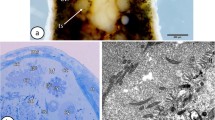Summary
-
1.
The spermatocytes and early spermatids of Vaginula possess a single Golgi element, consisting of an osmiophil externum and an osmiophobe internum. It is somewhat spherical, and is clearly observable in untreated living cells. In late spermatids the Golgi bodies break up into granules indistinguishable from mitochondria.
-
2.
The acrosome is a small structure and arises without the intervention of the Golgi bodies.
-
3.
The mitochondria are small osmiophil granules and rodlets. They remain scattered haphazard and do not give rise to Nebenkern or mitochondrial sheath of the middle piece.
-
4.
The Golgi body does not consist of vacuome and ‘chondriome actif’. It stains neither with janus green B, nor with neutral red, but stains deeply with nile blue sulphate and methylene blue.
-
5.
The mitochondria stain with janus green B, but not with nile blue sulphate.
-
6.
Neutral-red bodies appear in the ground cytoplasm of the spermatocytes and spermatids. These are probably segregation droplets.
Similar content being viewed by others
References
Baker, J. R.: The structure and chemical composition of the Golgi element. Quart. J. Microsc. Sci. 85, 1 (1944).
—: Further remarks on the Golgi element. Quart. J. Microsc. Sci. 90, 293 (1949).
—: Studies near the limit of vision with the light microscope, with special reference to the so-called Golgi bodies. Proc. Linnean. Soc. Lond., Session 162, 67 (1950).
—: Note on certain recent papers on the so-called Golgi apparatus. J. Roy. Microsc. Soc. 71, 94 (1951).
Bowen, R. H.: Studies on insect spermatogenesis. II. The components of the spermatid and their rôle in the formation of the sperm in Hemiptera. J. of Morph. 87, 79 (1922a).
—: Studies on insect spermatogenesis. V. On the formation of the sperm in Lepidoptera. Quart. J Microsc. Sci. 66, 595 (1922b).
Brice, A. T., R. P. Jones and J. D. Smyth: Golgi apparatus by phase contrast microscopy. Nature (Lond.) 157, 553 (1946).
Gatenby, J. B.: The cytoplasmic inclusions of the germ-cells. I. Lepidoptera. Quart. J. Microsc. Sci. 62, 407 (1917a).
- The Cytoplasmic inclusions of the germ-cells. II. Helix aspersa. Quart. J. Microsc. Sci. 1917b, 555.
—: The cytoplasmic inclusions of the germ-cells. Part V. The gametogenesis and early development of Limnaea stagnalis (L) with special reference to the Golgi apparatus and the mitochondria. Quart.J.Microsc. Sci. 63, 445 (1919).
Gatenby, J. B., and T. A. A. Moussa: The dorsal root ganglion cell of the kitten with sudan dyes and the Zernicke microscope. J. Roy. Microsc. Soc. 69, 185 (1949).
—: The sympathetic ganglion cell, with sudan black and the Zernicke microscope. J. Roy. Microsc. Soc. 70, 342 (1950).
Gresson, R. A. R.: A study of the male germ-cells of the rat and the mouse by phase-contrast microscopy. Quart. J. Microsc. Sci. 91, 73 (1950).
Gresson, R. A. R.: The Golgi substance. Cellule 54, 399 (1952).
Marshall, A. J.: The structure of the so-called Golgi body. Sci. Prog. (Lond.) 40, 71 (1952).
Oettlé, A. G.: Golgi apparatus of living human testicular cells seen with phase-contrast microscopy. Nature (Lond.) 162, 76 (1948).
Palade, G. E., and A. Claude: The nature of the Golgi apparatus. I. Parallelism between intracellular myelin figures and Golgi apparatus in somatic cells. J. of Morph. 85, 35 (1949a).
Palade, G. E., and A. Claude: The nature of the Golgi apparatus. II. Identification of the Golgi apparatus with a complex of myelin figures. J. of Morph. 85, 71 (1949b).
Parat, M.: Rapports du chondriome et du vacuome dans la “zone de Golgi”; constitution de cette zone. C.r.Assoc.Anat. 23, 383 (1928).
Parat, M., and J. Painlevé: Observations vitale d'une cellule glandulaire en activité. Nature et rôle de l'appareil réticulaire interne de Golgi et de l'appareil de Holmgren. C. r. Acad. Sci. (Paris) 179, 612 (1924).
Thomas, O. L.: The cytology of the neurones of Helix aspersa. Quart. J. Microsc. Sci. 88, 445 (1947).
—: A study of the spheroid system of sympathetic neurones with special reference to the problem of neurosecretion. Quart. J. Microsc. Sci. 89, 333 (1948).
Author information
Authors and Affiliations
Rights and permissions
About this article
Cite this article
Srivastava, M.D.L. Cytoplasmic organelles in the male germ-cells of Vaginula maculata (pulmonata, mollusca). Z.Zellforsch 40, 313–322 (1954). https://doi.org/10.1007/BF00394136
Received:
Issue Date:
DOI: https://doi.org/10.1007/BF00394136




